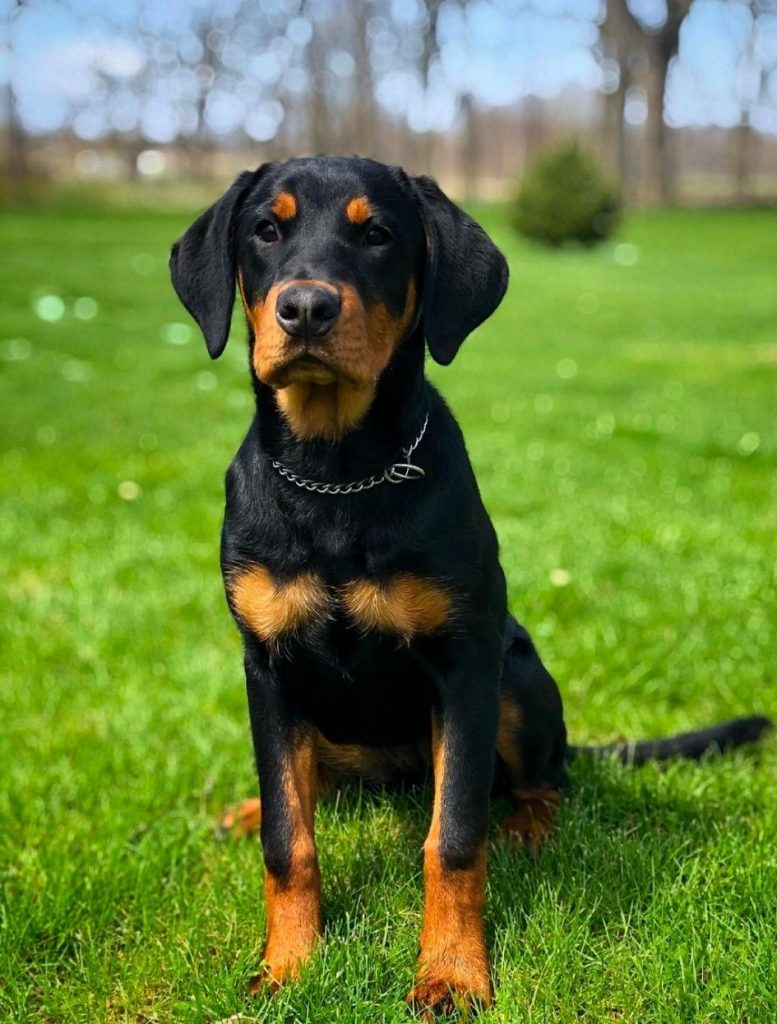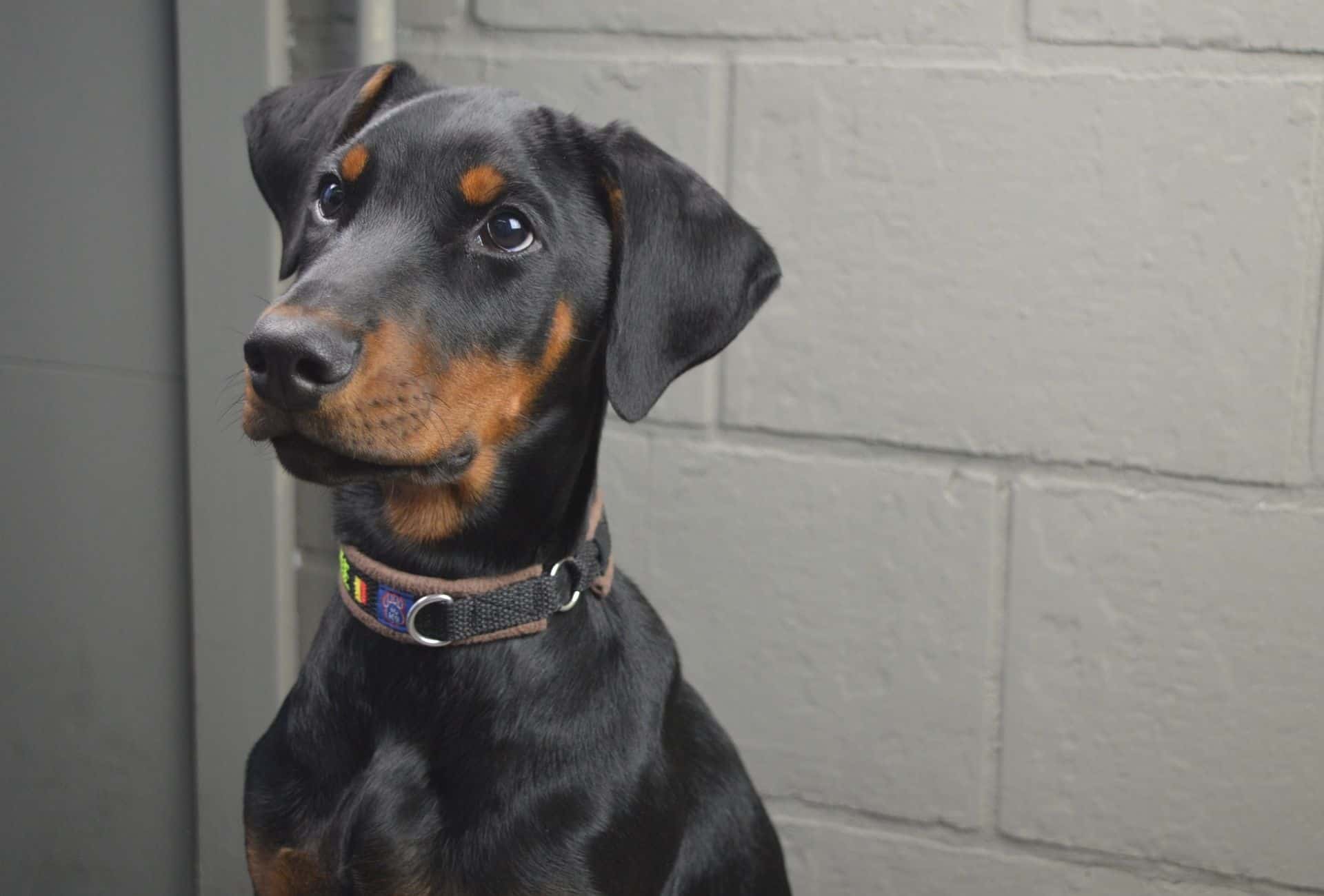Do you find yourself drawn to the commanding presence of a Rottweiler or the sleek elegance of a Doberman Pinscher? The answer might lie in a unique blend, a hybrid that combines the best traits of these two iconic breeds, offering a glimpse into the fascinating world of designer dogs and the intriguing possibilities that arise from crossbreeding.
The world of canine companions is vast and varied, with a rich tapestry of breeds, each possessing distinct characteristics and temperaments. Among the most captivating trends is the deliberate crossbreeding of purebred dogs, giving rise to what are often referred to as "designer dogs." These hybrid creations spark considerable interest, particularly when they involve breeds with such strong personalities and devoted followings as the Rottweiler and the Doberman Pinscher.
The Rottweiler and the Doberman Pinscher, while sharing a reputation for vigilance and protectiveness, also come with certain misconceptions. Both breeds are often perceived as intimidating, a perception that can be attributed to their imposing stature and inherent guarding instincts. However, with proper socialization and training, these dogs can become loyal and loving companions, capable of forming deep bonds with their families. As with any breed, early exposure to various environments, people, and other animals is crucial for developing a well-adjusted temperament.
The Doberman Pinscher, a breed of German origin, is relatively young in comparison to many other breeds. Its history is linked to a tax collector named Karl Friedrich Louis Dobermann, who, in the late 19th century, sought to create a dog with protective qualities. This involved a selective breeding program, combining different working dog breeds to achieve the desired traits. The result was a dog that was both intelligent and courageous, a loyal companion and an effective protector.
The Rottweiler, also of German heritage, has its roots in the Roman Empire. These dogs were initially used to herd cattle and later as draft animals. Over time, the Rottweiler evolved into a versatile breed known for its strength, loyalty, and protective instincts. Their imposing size and unwavering devotion make them a formidable presence, yet they are also capable of great tenderness and affection with their loved ones.
The crossbreeding of a Rottweiler and a Doberman Pinscher is a popular choice among those captivated by both breeds. The resulting hybrid, often called a "Rotterman," combines the robust build of the Rottweiler with the sleek agility of the Doberman. This can result in a dog that is both physically impressive and highly trainable, possessing a blend of strength, intelligence, and loyalty.
Here's a look at some of the key characteristics of the Rottweiler and the Doberman Pinscher:
| Feature | Rottweiler | Doberman Pinscher |
|---|---|---|
| Origin | Germany | Germany |
| Purpose | Herding, Draft, Guarding | Protection, Companionship |
| Size | Large | Large |
| Weight | 80-135 pounds | 60-100 pounds |
| Temperament | Loyal, Protective, Confident | Intelligent, Alert, Trainable |
| Coat | Double coat, short | Single coat, short |
| Lifespan | 8-10 years | 10-12 years |
| Exercise Needs | High | High |
| Trainability | Moderate to High | High |
| Grooming Needs | Low | Low |
It is worth noting that the Doberman Pinscher, known for its versatility, was created through the crossbreeding of working dogs. This highlights the potential of combining traits to achieve a specific set of qualities in a dog.
The hybrid dog, such as the Rotterman, inherits a blend of characteristics from its parent breeds. The exact outcome can vary depending on the specific genetics involved, but some general traits are commonly observed. These dogs are often intelligent, loyal, and protective, mirroring the traits of both Rottweilers and Dobermans.
One aspect to consider with any mixed-breed dog is the potential for health issues. Both Rottweilers and Doberman Pinschers are predisposed to certain health problems, so it is important to be aware of these and to work with a responsible breeder. Some common health concerns include hip dysplasia, bloat, and cardiac issues.
The Rotterman's appearance can be a striking combination of Rottweiler and Doberman characteristics. They might have the robust muscular build of the Rottweiler combined with the elegant lines and athleticism of the Doberman. Their coat colors can vary, often reflecting the typical markings of both breeds, such as black and tan, or variations thereof. With their penetrating brown eyes and alert expression, they often exude a powerful and confident presence.
However, one must remember that the temperament of any dog is greatly influenced by its upbringing. Early socialization and consistent training are crucial for any hybrid dog, as they are for purebreds. Exposing a Rotterman puppy to various social situations, people, and other animals from an early age helps them develop into well-adjusted and friendly companions. Training should be a continuous process, emphasizing positive reinforcement to encourage good behavior and obedience.
The education of a Rotterman (or any mixed breed) should begin from puppyhood. This crucial period lays the foundation for their future behavior and temperament. It's vital that puppies are not separated from their mother and littermates before eight to nine weeks of age. During this time, they learn important social skills and the proper ways to interact with other dogs.
For those considering a Rotterman, it's essential to find a reputable breeder who prioritizes the health and well-being of their dogs. A responsible breeder will screen their breeding dogs for potential health issues and provide a proper early environment to ensure puppies get off to the right start.
It is imperative to emphasize that a dog's potential temperament and behavior are influenced by their upbringing and environment. Just as there is no guarantee that two Rottweilers, or two Dobermans, will have identical personalities, the same holds true for a Rotterman.
One may also encounter the "Pitweiler," a cross between a Rottweiler and an American Pit Bull Terrier. This hybrid is a strong, muscular dog. The American Panja Mastiff is a different breed, one that is created by crossing Rottweilers and American Pit Bull Terriers. It is important not to confuse the two.
When it comes to the question of a fight between a Rottweiler and a Doberman, a definitive answer is elusive. Several factors, including individual temperament, training, and physical condition, would all play a role in the outcome. Instead of focusing on a hypothetical battle, it's more productive to consider the qualities that make each breed valuable. They both have unique strengths, making them excellent companions.
Remember that all dogs, regardless of breed, deserve responsible ownership. Providing proper care, training, and socialization will ensure any dog can become a valued and well-behaved member of the family.
If you are ready to welcome a new canine companion into your life, visiting your local animal shelter to inquire about a "Rotterman" or other dog in need of a home could be a great step. The rewards of giving a deserving dog a loving home are immeasurable.
It's also important to be cautious when mixing breeds with strong temperaments, as this can lead to instability. However, with careful breeding, early socialization, and consistent training, a Rotterman can thrive.
In conclusion, the Rotterman, a mix of Rottweiler and Doberman, presents a fascinating combination of traits from two remarkable breeds. By understanding their history, characteristics, and needs, potential owners can prepare themselves for the responsibility and joy of welcoming a Rotterman into their families. While it's crucial to remember that crossbreeding is not an exact science, the result can be a loyal, intelligent, and protective companion that embodies the best qualities of both parent breeds.


